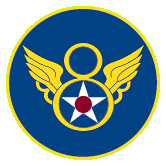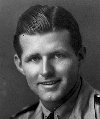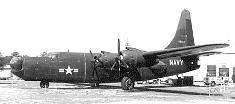|
 TOP SECRET MISSION: PROJECT "ANVIL"
TOP SECRET MISSION: PROJECT "ANVIL"
By: William W. Wells, 55th.FS, 20th.FG
 Lt. Joseph P. Kennedy, Jr.  A U.S.Navy PB4Y  A PV-1 Ventura like the one used in Project Anvil. |
| � � � � It was one of those rare summer days in England, warm and sunny, August 12, 1944. On this day the 20th. Fighter Group flew two missions. The first one was east of the Seine River escorting B-17's on another bombing mission with our P-51s strafing their way back home hitting any moving form of transportation. The second mission, just east of paris, was similar to the first; bombing by heavies, fighter-bombing and then strafing targets of opportunity. Both were quite successful. � � � � In the meantime, those pilots not on the main missions were on standby in their respective operations areas. About 4p.m., the phone in the 55th. Squadron Operation rang. Someone from Group Operations called to tell us to get a flight of four P-51's in the air at once and fly to a field called Winfarthing-Fersfield located about 15 miles southwest of Norwich, and about 60 miles east of Kings Cliffe. We were to report to a Commander Smith of the US Navy. Lt. John Klink and I with two other pilots (unknown at this time) took off as directed and reported to CommanderSmith, US Navy, at Fersfield for the mission briefing. � � � � Commander Smith took us into the briefing room and closed the door. He began by saying that this mission was, next to the invasion of Normandy itself, the highest classified mission of the war. In fact it was 17 years after the war before the facts of this mission, called Project "Anvil" were made public. Needless to say, he swore all of us to secrecy. � � � � Commander Smith told us of the extreme concern of the Allied High Command over the unleashing of the German V-1 and V-2 robot finds. For months, the Allies had made countless bombing strikes on suspected V-1 and V-2 launching sites without much success and yet with the loss of nearly 450 planes and 2,900 aviators. Some other means of stopping this onslaught was desperately needed. � � � � It was for this reason that Project "Anvil" was conceived. The idea was to create a pilotless "drone" aircraft with some two tons of high explosives and, guided by remote control from another plane, send it crashing onto a launching site. This idea had previously been used in the Pacific Fleet where a specially designed drone had been loaded with explosives and directed against targets. Something bigger and more powerful was needed here. � � � � Commander Smith explained how this Project "Anvil" was to be implememnted. He pointed out a PB4Y Liberator (B-24) painted all white parked on the side of the field. This he said, was our drone; but because of its heavy weight, it would have to have a pilot and co-pilot to take it off and get it set on course. After it was on course and before it reached the channel, the two pilots would bail out, leaving the PB4Y under the control of accompanying radio control planes. � � � � He went on to tell us that the drone was loaded with 374 boxes, containing 55 pounds of Torpex each, and six Mark-9 demolition charges containing 100 pounds of TNT each. This came to 21,470 pounds of high explosives. He then told us of the other planes which were to participate in this project. The first plane to take off was an RP-38 photo ship, then a Mosquito photo recon ship, then two PV-1 Venturas, especially equipped with radio equipment, for guiding the drone. After this, the drone (PB4Y) itself would take off and finally the four P-51's. We were told to climb up and maintain about 1,500 feet above the PB4Y drone at all times until it was launched on to the target. We were then to accompany the PV-1's back to Fersfield base and report to Commander Smith. � � � � At 5:52p.m. the aircraft proceeded to take off in their proper sequence. The drone leveled off at 2,000 feet; the photo planes went up to 15,000 feet; the PV-1's were also at 2,000 feet but about 200 feet on either side of the drone. We took our position at 3,500 fetand throttled way back, constantly turning so as not to over-run the drone. � � � � The Nazi occupied island of Helgoland was the target, since this island was a proving ground and launch site for V-2 missiles. I'm sure all of the Allied pilots remember this island fortress in the North Sea. We drew flak from here every time we crossed the Danish coast. � � � � The remote control system of the PV-1's and the drone were to be checked at five points. The first point "Abel" was over Framlingham, about 25 miles southeast of Fersfield. Then the drone would turn north to point "Baker" at Beccles, thence south to point "Charlie" at Clacton-on-Sea and on to point "X-Ray" near Manston airfield, wherethe PV-1s would take control and the two pilots would bail out. Then the drone would be directed to pont "Dog", about two miles south of Dover and thence toward the target some 350 miles to the northeast. � � � � The drone and its control ships and the P-51s moved towad Checkpoint "Abel". Just before they reached Framlingham, the drone pilot signaled by radio that he was ready to conduct the first radio-control check. Point "Abel" was passed at 6:15 p.m. the group then turned left for point "Baker" over Beccles. We flew over Heveningham Hall, the home of Lord Huntingfield, crossed the Blyth River and could see the North Sea off our right wings. The tall tower of St. Michael's loomed ahead in the town of Beccles. At 6:20, the drone was over a field near the villages of St. Margaret and St. Lawrence. We, in the escort P-51's, were in a slow, lazy right turn and were looking right down on the drone directly below us. Suddenly it exploded in a searing orange ball of fire blowing us up into the air another 1,000 feet. A huge mushroom cloud boiled up to 25,000 feet and nothing remained of the drone or the two pilots. � � � � We returned to Fersfield and landed. We told Commander Smith what had happened even though he could hear the blast and see the high cloud. He told us that, sadly enough, the same thing had happened the previous week to another drone. He also told us that the pilot, in this joint Navy-Army Project "Anvil", who had been on our mission was Joseph P. Kennedy, Jr., the son of the Ambassador to the court of St. James, Joseph P. Kennedy, Sr., from Boston. Young Joe was an outstanding flier and had volunteered for this mission knowing full well how dangerous it was. A true hero, he was awarded the Navy Cross posthumously. � � � � On page 176 of the Second Edition of King's Cliffe, column one, paragraph 8, are two sentences that read: � � � � "In addition to the above two missions, the 20th. Group also sent four planes led by Lt. Klink on a special escort mission. The planes returned safely." � � � � Even 20th. Fighter Group Operations wasn't told any details of the project.
|
RETURN TO THE 20TH.FG
Reprinted From King's Cliffe Remembered Jan., 1984 Issue
Unless otherwise noted, all content � copyright The Art of Syd Edwards 1998-1999. All rights reserved and reproduction is prohibited.
